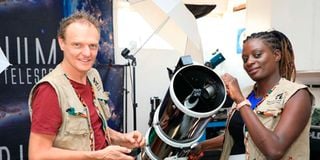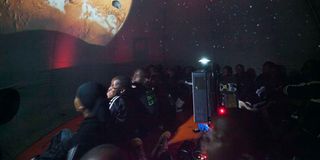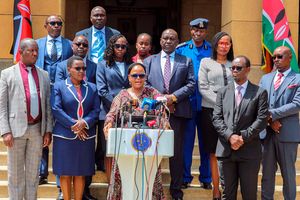Premium
An out-of-this-world tour of the night sky

Susan Murabana and Daniel Chu-Owen during the interview at their home in Nairobi on June 15. They are the owners of the Travelling Telescope, a Kenyan company that educates people about astronomy.
What you need to know:
- ‘Lifestyle’ team joins the once-a-month Travelling Telescope’s Star Safari, where they sight different planets, the moon, stars and other interesting phenomena of the universe
- It was an exciting morning for observers as Mercury, Venus, Mars, Jupiter and Saturn were sequentially aligned for the first time in 18 years.
What do you think is up there? When you stare deep into the night sky all you see is twinkling lights that are said to be millions of light years away. Some yet to be named. Others yet to be discovered.
Other than the ocean, space is probably the most unexplored phenomenon known to humankind.
That is why, out of curiosity, on June 4 the Lifestyle team joined the once-a-month Travelling Telescope’s Star Safari. The only prayer for that night was that the sky would be clear enough for the journey to be as entertaining as expected. We were in Corner Baridi (“Cold Corner” in Kiswahili) near Ngong and as soon as the sun set, the unforgiving cold began to creep in, true to the name of the place.
The tents were already pitched and dinner eaten. Most of those in attendance were families with young children. By 8 o’clock, the stars shone bright in the company of a crescent moon, which was perfect for stargazing, according to Daniel Chu-Owen, the guide of the night.
“If there was a bright full moon, we would not be able to see the stars so well because the moon is closer to us than those stars. The light from the sun that passes through the moon would surpass the brightness of those stars sending light to us over,” he said.
With no clouds in sight and all lights off, the sky gave way to one of the Milky Way’s spiral arms carrying clusters of stars. Chu marvelled the crowd with his knowledge on constellations such as Scorpio, Sagittarius and the Big Dipper, pointing at them with a green laser that pierced through the darkness.
“The Southern Cross constellation points to the South Pole and is used in navigation. To its left is Alpha Centauri which is one of the stars closest to our star, the Sun,” narrated Chu.
The telescopes were set up in the middle of the crowd. The Unistellar and Skywatcher were guarded in a red LED circle to prevent crowding and tripping over the telescopes. One by one, curious children and parents took turns to see the wonders in the sky, constantly reminded not to touch the telescope, which would push them out of focus. Each one stepped away uttering a word in amazement.
The Skywatcher was the largest telescope in the circle that pointed at the moon. At first glance, it felt like the moon was in reach; with its craters appearing as clear as a picture. The other telescope, the Unistellar, was smaller but not any less powerful.
It was computerised and controlled using the guide’s phone, with the keying in of coordinates of galaxies and nebulas that continued to wow guests throughout the night. This telescope also has the ability to capture photos of objects seen and send them to the mobile phone it is connected to.
Even if you are not an astronomer, this makes it easier for people to get involved in citizen science.
“It is like an escape. For a moment you look up into the sky and remember that you are a small part of the universe,” said Travelling Telescope CEO Susan Murabana.
Despite the freezing cold that had people wrapped in shukas, there was a scent of euphoria in the air. Strangers chatting about what they have seen through the telescopes. Children from different families running around and playing.
When Chu announced that there could be a sighting of planets Jupiter and Saturn at 5am, it was shocking to see that many of the campers were awake and eager to see.’
It was also an exciting morning for observers as Mercury, Venus, Mars, Jupiter and Saturn were sequentially aligned for the first time in 18 years.
Susan Murabana and Daniel Chu-Owen have dedicated their lives to educating every individual they cross about space and watching them marvel of the wonder that never ceases to amaze regardless of who they are or where they come from.
“I always loved maths and sciences in school. When I was in university, I volunteered to teach basic sciences in schools with a group of young students travelling all over Africa. I chose to teach about the solar system. That is when I first got interested in astronomy,” said Susan.
Susan had just finished her university studies at Catholic University of Eastern Africa in Nairobi when she first looked through a telescope and saw the moon and planet Saturn.
She then joined an outreach programme known as Global Hands on Universe through which she was awarded a scholarship to join an online master’s programme in astronomy with James Cook University in Australia. From the beginning, she decided she wanted to share her knowledge of astronomy with others, especially young children.
Chu’s journey with astronomy started in an attic in the United Kingdom as a young child.
“I put my bed under the window and watched the sky gradually change. There was a partial eclipse when I was about 12 years old. My father was a builder so he had a welding visor that I used to look at the sun which could harm your eyes. I saw a chunk taken out of the sun as the moon crossed over Earth,” says Chu.
Unfortunately, Chu caught glandular fever that left him weak and unable to function normally. However, it gave him a chance to reconnect with astronomy and led him to buy his first telescope at about Sh10,000. As he grew older, he started sharing what he saw in the sky which gave birth to the Travelling Telescope.
“I did not have much interest in science and was terrible at maths in school. I focused on arts and music then later got into photography and film. I later started making documentaries which brought me to Kenya,” he says.
An anticipated solar eclipse event forced Susan’s and Chu’s paths to cross in 2013.

Rusinga School students learning about Mars in a planetarium provided by the Travelling Telescope.
“I got a tip that the eclipse was going to happen with the path of totality to be experienced in Turkana County. In conjunction with the Rotary Club of Nairobi, I organised an event where people would experience the event and camp on the shores of Lake Turkana,” Susan says.
As word spread about her event, Susan received emails and donations from well-wishers.
Astronomers from Ukraine, Denmark, the United Kingdom and Japan travelled to witness the event. She received 5,000 safe solar glasses from a well-wisher in the US to distribute in schools. One of the other emails was from Chu.
“He introduced himself and asked if he could film the whole event from the moment I picked up the solar glasses to distributing them. He also offered to chauffeur me to pick up the glasses, which was great timing since I did not have any fuel in my car to make the trip,” Susan says.
As they travelled to Turkana, Chu and Susan realised that they had more in common than they thought.
Susan’s first impression was that Chu was just a filmmaker. She had no interest being involved with anyone who had no interest in astronomy, her first love. Their conversations on the trip, however, changed her perspective.
Chu, on the other hand, was taken by her and after a while decided to relocate to Kenya. They then tied the knot in 2013. Thereafter, they revived the Travelling Telescope and started outreach programmes and astronomy tourism.
“We were lucky to find each other the way we did because we both had this passion for the sky even though we both never experienced that in school. That is what drives our passion to educate and share this knowledge with children,” says Susan.
Most schools in Kenya cannot afford to buy a planetarium or a telescope so the couple wanted to add that experience to the education of children across the country. Chu believes that the sky is a free laboratory where children only need someone to guide them through it at least one night under a clear sky.
“Children are our future leaders. They will make more informed decisions when they get exposed to such eye-opening experiences. Once they see how important this is, the future leaders will invest in Science,” said Susan.
In eight years, they have been to more than 50 schools all over the country teaching children and communities about space using a mobile inflatable planetarium which can hold 40 children at once.
When Susan was a student, there was no university offering any astronomy-related degrees at that time. Now the University of Nairobi offers a bachelor’s degree in astronomy and astrophysics. The couple has worked with many graduates, some who were inspired by them during school visits.
“We know that not everyone can be an astronomer but we would like everyone to have an appreciation of planet Earth. We look out into space and see all these other planets and we cannot live there because we cannot breathe there. It changes your perception of our home planet,” Chu says.
With a healthy mix of art and science, Susan and Chu grew the Travelling Telescope into their main source of income. Their expeditions have given them opportunities to share cosmic wonder with celebrities such as Madonna.
“Whenever we have our star safaris, no one is above anyone else. Rich or poor, young or old, everyone looks through the same telescope and experiences the same feeling of amazement. We went to a Maasai community where even the elders came to contribute and teach the children about what they knew about the sky,” says Susan, proving that astronomy might be the unifying factor the world needs.
In 2020, the Covid-19 shut down the country forcing the couple to halt their star safaris. However, Susan and Chu took the opportunity to work on a one of a kind project, a planetarium made out of bamboo.
Using the bamboo in their backyard, they created the dome-shaped theatre with a full dome projector in the middle. Then there were beanbags and wooden lounge chairs arranged into a circle for watchers to lie down for their outer space experience. The dome is covered in black draping to block out any light from entering the space, giving the illusion of pitch dark space with only light coming from planets and the stars.
Various schools now visit the planetarium to expose their children to Science, Technology, Engineering and Mathematics (Stem) subjects as part of their curriculum.
“Building a permanent planetarium is expensive even for governments but it is worth it. We once visited a school where one of the children stepped out and said that he used to think that scientists lied but now he believes in science,” says Susan.
A planetarium, however, cannot beat the feeling of seeing and realising how real the universe is for yourself in a clear night sky. Yet climate change seems to be affecting astronomy tourism.
Space science
The consistency of weather patterns has been distorted, which makes it hard to predict when there will be a cloudless sky. Light pollution also makes it hard for people to see stars in cities such as Nairobi.
“That is why we prefer to take our guests to Laikipia, Maasai Mara or Kajiado depending on their preference. Some hotels and lodges call us to host star safaris for their guests. When we were in Laikipia, the sky was gorgeous, dry and clear, which are the optimum conditions for astronomy. However, the locals knew that clear skies meant that their cows would starve,” says Chu.
Space science continues to take root in Kenya with the revival of the Malindi Space Station and the creation of the Kenya Space Agency.
Susan has been recognised for her work in space science by being chosen as a Space4Women Mentor by The United Nations Office for Outer Space Affairs, a board member of World Space Week and the President of Africa Planetarium Society — an affiliate of International Planetarium Society.
There are currently 10 people in space right now who are conducting different experiments on vegetables growing in the International Space Station, how human beings can survive in space and monitoring how the earth is changing due to climate change.
The National Aeronautics and Space Administration (NASA) plans to send the first woman to the moon through the Artemis programme with the Space Launch System rocket and Orion spacecraft. Artemis is the first in a series of increasingly complex missions that will enable human exploration to the Moon and Mars.
As Lifestyle ends the out-of-this-world experience with the Travelling Telescope’s Star Safari, it is hard to avoid one of those pithy wise sayings that seem to summarise even the most complex ideas in a few words.
“Man must rise above the Earth – to the top of the atmosphere and beyond – for only thus will he fully understand the world in which he lives,” said Socrates, a long time ago, on the importance of space science for humankind.




